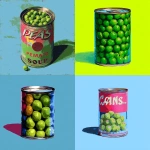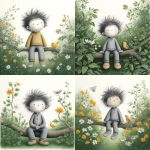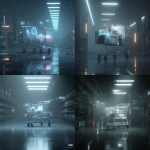Explore the Best AI Image Gallery

Pixel Perfect: How AI is Transforming Product Photography
The world of e-commerce relies heavily on captivating product photography to entice customers. Traditionally, this has involved professional photographers, elaborate setups, and time-consuming post-processing. However, a new wave of innovation is sweeping through the industry, driven by artificial intelligence (AI). AI-powered tools are revolutionizing product photography, making it more efficient, accessible, and creatively versatile.
Applications of AI in Product Photography
AI is being integrated into various aspects of product photography, from image capture to post-processing. Some key applications include:
- Automated Image Generation: AI algorithms can generate realistic product images from 3D models or basic descriptions, eliminating the need for physical product shoots. This is particularly beneficial for businesses with a large inventory or frequently changing products.
- Style Transfer and Enhancement: AI can apply artistic filters or stylistic effects to product images, creating unique and eye-catching visuals that stand out from the crowd. It can also enhance image quality by adjusting lighting, color balance, and sharpness.
- Background Removal and Replacement: AI-powered tools can automatically detect and remove product backgrounds, allowing for seamless integration onto different backgrounds or layouts. This saves time and resources compared to manual editing.
- Image Editing and Retouching: AI can automate tedious tasks such as removing blemishes, smoothing textures, and adjusting proportions, resulting in high-quality images that meet professional standards.
Creative Possibilities Unleashed
AI is not just about automating tasks; it also empowers photographers and designers with new creative possibilities:
- Experimentation and Iteration: AI allows for rapid prototyping and iteration of product images, enabling designers to explore different styles, compositions, and variations quickly.
- Personalized Product Views: AI can generate customized product images based on user preferences, such as specific angles, colors, or accessories. This enhances the shopping experience and allows customers to visualize products in their own context.
- Interactive and Dynamic Content: AI can create interactive product visualizations, allowing users to rotate, zoom, and explore products in 3D. This immersive experience provides a deeper understanding of product features and functionality.
Ethical Considerations
While AI offers immense potential for product photography, it is crucial to address the ethical implications:
- Transparency and Disclosure: It is important to clearly indicate when AI has been used in creating product images to maintain transparency with consumers.
- Bias and Fairness: AI algorithms can inherit biases from the data they are trained on, potentially leading to unfair or discriminatory representations of products. It is essential to ensure that AI systems are trained on diverse and representative datasets.
- Job Displacement: The automation capabilities of AI may raise concerns about job displacement for photographers and other professionals in the industry. It is important to consider the impact on employment and explore strategies for reskilling and upskilling workers.
Future Trends
The field of AI in product photography is rapidly evolving, with several exciting trends on the horizon:
- Integration with AR/VR:** AI-powered product visualization will become increasingly integrated with augmented reality (AR) and virtual reality (VR) technologies, providing even more immersive and interactive shopping experiences.
- Personalization at Scale: AI will enable the creation of highly personalized product images tailored to individual customer preferences, leading to a more customized and engaging e-commerce experience.
- AI-Driven Storytelling:** AI can be used to generate narratives and stories around products, enhancing their emotional appeal and creating deeper connections with consumers.
Conclusion
AI is transforming product photography in profound ways, making it more efficient, creative, and accessible. As technology continues to advance, we can expect even more innovative applications that will reshape the e-commerce landscape. By embracing AI responsibly and addressing ethical considerations, we can unlock its full potential to enhance the shopping experience for consumers and empower businesses to thrive.






](https://images.ai-img.art/thumbnails/150/6a9bb97a3f1c45ab616724cc54bca010cbcc2d658a9c0e4581aa181c88046444.webp)
](https://images.ai-img.art/thumbnails/150/6a577517a359cd2bc6212d6b0f12c7cab660841317023550a76c84f409c7f2d0.webp)





](https://images.ai-img.art/thumbnails/150/45237dfa7845159b860f9e234c48c4418e8efcb52b4d15da4493f46e6a99f337.webp)




](https://images.ai-img.art/thumbnails/150/1b14bd827b740aca3b0d8efa7ed6865e28c7c8382172f3f565c96b6c5f64ca78.webp)










](https://images.ai-img.art/thumbnails/150/065f0b2e150f4cc43a9da80d822e8a385e9e50f2f6ff2cc3be7639cfd74952da.webp)



















